A Student Primer on How to Thrive in Engineering Education during and beyond COVID-19
Abstract
1. Introduction
2. Step 1: Begin with the End in Mind
“To ‘Begin with the End in Mind’ means to start with a clear understanding of your destination. It means to know where you’re going so that you better understand where you are now and so that the steps you take are always in the right direction.”Stephen Covey [11]
2.1. Knowing the Educational Objectives and Learning Outcomes
“We cannot say how to teach for understanding or which material and activities to use until we are quite clear about which specific understandings we are after and what such understandings look like in practice.”Wiggins and McTighe [12]
- Program Educational Objectives (PEOs): PEOs are broad statements that describe what graduates are expected to attain within a few years of graduation (and unlike the following two outcomes, these objectives are not necessarily expected at graduation time).
- Program Learning Outcomes (PLOs): PLOs are statements that describe what students are expected to know and be able to do by the time of graduation. PLOs are at some places referred to as graduate attributes (GAs) [in the Washington Accord] or as student outcomes (SOs) [e.g., with US Accreditation Board for Engineering and Technology (ABET)].
- Course Learning Outcomes (CLOs): CLOs refer to what students should be able to know, do, and value by the end of a course. CLOs are alternatively referred to as intended learning outcomes (ILOs) [e.g., in the UK] and subject learning outcomes (SLOs) [e.g., at Malaysia and Hong Kong].
2.2. Aligning Effort with Goals, Objectives, and Outcomes
“The main thing is to keep the main thing the main thing.”Stephen Covey [11]
2.3. Motivation, Self-Efficacy, and Learning How to Prioritize
“Explore the world. Nearly everything is really interesting if you go into it deeply enough.”Richard Feynman
3. Step 2: Upgrade Your Metacognitive Skills
“One of the most important aspects of cognition is metacognition—the process of reflecting on and directing one’s own thinking.”Pellegrino et al. [18]
3.1. Types and Levels of Learning
“By educational objectives, we mean formulation of the ways in which students are expected to be changed by the education process, i.e., the ways in which they will change in their thinking, their feelings, and their actions.”Bloom et al. [23]
3.1.1. Bloom’s Taxonomy
3.1.2. Four Types of Knowledge
- Factual knowledge refers to the basic knowledge students must know to be acquainted with a discipline or to solve a problem in that discipline.
- Conceptual knowledge refers to the interrelationship between the basic facts forming a bigger conceptual structure.
- Procedural knowledge refers to knowledge that relates to doing something and using developing skills, methods, techniques, and algorithms.
- Metacognitive knowledge involves broad knowledge of cognition in general as well as self-awareness.
3.1.3. Cognitive Activities
3.1.4. Affective Emotion-Based and Psychomotor Action-Based Activities
3.2. Avoiding Common Learning Mistakes
“To make no mistakes is not in the power of man; but from their errors and mistakes; the wise and good learn wisdom for the future.”Plutarch
3.3. Learning 101: Learn How to Learn
“Is there anyone so wise as to learn by the experience of others?”Voltaire
- Spaced out learning: instead of concentrating all your learning sessions together, you should space out your learning sessions over time.
- Interleaving: instead of blocking practice sessions (i.e., revising one topic and then the other), practice interleaving (this will be more effortful but will help discriminate ideas resulting in more robust learning).
- Testing: instead of rereading material, you should test yourself on the learned knowledge or practice mental retrieval.
- Variety: instead of always learning in the same modality and environment, vary the conditions and the environmental context of your learning.
4. Step 3: Aim for Holistic Learning
“You don’t understand anything until you learn it more than one way.”Marvin Minsky
4.1. Become a System Thinker
“We’re blind to our blindness. We have very little idea of how little we know.”Daniel Kahneman
4.2. Building a Lattice Work of Models
“You’ve got to have models in your head. In addition, you’ve got to array your experience both vicarious and direct on this latticework of models.”Charlie Munger [31]
4.3. Be Well-Rounded
“To rely on a single model is hubris. It invites disaster.”Scott Page [29]
5. Step 4: Become Coachable
“Try to learn. Be coachable. Try to learn from everybody, especially those who fail.”David Foster Wallace
5.1. Seek Formative Assessment
“As soon as students get a grade, the learning stops. We may not like it, but the research […] shows that this is a relatively stable feature of how human minds work.”Dylan Wiliam
5.2. Learn to Think Like an Assessor
“When students become their own teachers they exhibit the self-regulatory attributes that seem most desirable for learners (self-monitoring, self-evaluation, self-assessment, self-teaching).”John Hattie
5.3. Develop Self-Assessment Skills
“When students become their own teachers they exhibit the self-regulatory attributes that seem most desirable for learners (self-monitoring, self-evaluation, self-assessment, self-teaching).”John Hattie
6. Step 5: Take Ownership of Learning
“Learning results from what the student does and thinks and only from what the student does and thinks. The teacher can advance learning only by influencing what the student does to learn.”Herbert A. Simon
6.1. Active Learning
“Converging results from diverse fields suggest that a passive organism learns little or nothing. Efficient learning means refusing passivity, engaging, exploring, and actively generating hypotheses and testing them on the outside world.”Stanislas Dehaene
6.2. Leverage What Can Be Leveraged
“Entrepreneurship is a mindset, an outlook that shapes the way you see the world and the possibilities that it holds.”Jim Plummer
6.3. Collaboration and Teamwork
“Critical thinking and problem solving, communication and collaboration, and creativity and innovation are three top-drawer skill sets in our toolbox for learning, work, and life in the 21st century.”Trilling and Fadel [47]
7. Step 6: Focus on Developing Authentic Skills
“The most important method of education … always has consisted of that in which the pupil was urged to actual performance.”Albert Einstein
7.1. Develop an “Understanding” of the “Big Ideas”
“What we are claiming, based on both common sense and the research in cognition, is that no skill can be integrated into a powerful repertoire unless the learner understands the big ideas related to using the skill wisely.”Wiggins and McTighe [12]
7.2. Transfer of Learning
“Transfer must be the aim of all teaching in school—it is not an option— because when we teach, we can address only a relatively small sample of the entire subject matter.”Wiggins and McTighe
7.3. Uncoverage Rather Than Coverage
“Teaching [and learning] specific topics or skills without making clear their context in the broader fundamental structure of a field of knowledge is uneconomical.”Jerome Bruner
8. Step 7: Become a Lifelong Learner
“Give a man a fish, and you feed him for a day. Teach a man to fish, and you feed him for a lifetime.”English Proverb
8.1. Develop a Mindset for Continuous Lifelong Learning
“Most of what our students need to know hasn’t been discovered or invented yet. ‘Learning how to learn’ used to be an optional extra in education; today, it’s a survival skill.”Dylan Wiliam
8.2. Master the Instrumental Knowledge for Lifelong Learning
“They know enough who know how to learn.”Henry Adams
8.3. Develop by Practice the Skills for Lifelong Learning
“Life is like riding a bicycle. To keep your balance you must keep moving.”Albert Einstein
9. Putting These Ideas in Practice
9.1. About Labs and Practical Work
9.2. About Digital Divides
9.3. Role of Educators
10. Conclusions
Author Contributions
Funding
Conflicts of Interest
References
- Qadir, J.; Yau, K.L.A.; Imran, M.A.; Al-Fuqaha, A. Engineering Education, Moving into 2020s: Essential Competencies for Effective 21st Century Electrical and Computer Engineers. In Proceedings of the 2020 Frontiers in Education (FIE), Uppsala, Sweden, 21–24 October 2020. [Google Scholar] [CrossRef]
- Froyd, J.E.; Wankat, P.C.; Smith, K.A. Five major shifts in 100 years of engineering education. Proc. IEEE 2012, 100, 1344–1360. [Google Scholar] [CrossRef]
- Hanrahan, H. The Washington accord: History, development, status and trajectory. In Proceedings of the 7th ASEE Global Colloquium on Engineering Education, Cape Town, South Africa, 19–23 October 2008; pp. 19–23. [Google Scholar]
- Spady, W.G. Outcome-Based Education: Critical Issues and Answers; ERIC US Department of Education: Washington, DC, USA, 1994.
- Qadir, J.; Shafi, A.; Al-Fuqaha, A.; Taha, A.E.M.; Yau, K.L.A.; Ponciano, J.; Hussain, S.; Imran, M.A.; Muhammad, S.S.; bin Rais, R.N.; et al. Outcome-Based Engineering Education: A Global Report of International OBE Accreditation and Assessment Practices. In Proceedings of the American Society for Engineering Education (ASEE) Annual Conference 2020, Montréal, QC, USA, 20–24 June 2020. [Google Scholar]
- Sachs, J.; Schmidt-Traub, G.; Kroll, C.; Lafortune, G.; Fuller, G.; Woelm, F. The Sustainable Development Goals and COVID-19. Sustainable Development Report 2020. Available online: https://s3.amazonaws.com/sustainabledevelopment.report/2020/2020_sustainable_development_report.pdf (accessed on 18 May 2020).
- World Bank. World Bank Education and COVID-19; World Bank: Washington, DC, USA, 2020. [Google Scholar]
- Goldberg, D.E.; Somerville, M. A whole new engineer. In The Coming Revolution in Engineering Education; ThreeJoy Associates Inc.: Douglas, MI, USA, 2014. [Google Scholar]
- Taleb, N.N. Antifragile: Things That Gain from Disorder; Random House: New York, NY, USA, 2012; Volume 3. [Google Scholar]
- Qadir, J. The Triple Imperatives of Online Teaching: Equity, Inclusion, and Effectiveness. 2020. Available online: https://edarxiv.org/zjdc7/ (accessed on 18 May 2020).
- Covey, S.R. The 7 Habits of Highly Effective People: Powerful Lessons in Personal Change; Simon and Schuster: New York, NY, USA, 2004. [Google Scholar]
- Wiggins, G.; McTighe, J. Understanding by Design; ASCD: Alexandria, VR, USA, 2005. [Google Scholar]
- Cambron-McCabe, N.; Lucas, T.; Smith, B.; Dutton, J. Schools That Learn: A Fifth Discipline Fieldbook for Educators, Parents, and Everyone Who Cares about Education; Broadway Business: New York, NY, USA, 2012. [Google Scholar]
- Biggs, J. Enhancing teaching through constructive alignment. High. Educ. 1996, 32, 347–364. [Google Scholar] [CrossRef]
- Qadir, J.; Imran, M.A. Learning 101: The Untaught Basics. IEEE Potentials 2018, 37, 33–38. [Google Scholar] [CrossRef]
- Dehaene, S. How We Learn: Why Brains Learn Better Than Any Machine… for Now; Viking: New York, NY, USA, 2020. [Google Scholar]
- Newport, C. How to Become A Straight-A Student: The Unconventional Strategies Real College Students Use to Score High While Studying Less; Three Rivers Press: New York, NY, USA, 2007. [Google Scholar]
- Pellegrino, J.W.; Chudowsky, N.; Glaser, R. Knowing What Students Know: The Science and Design of Educational Assessment; ERIC US Department of Education: Washington, DC, USA, 2001.
- Dunlosky, J.; Rawson, K.A.; Marsh, E.J.; Nathan, M.J.; Willingham, D.T. Improving students’ learning with effective learning techniques: Promising directions from cognitive and educational psychology. Psychol. Sci. Public Interest 2013, 14, 4–58. [Google Scholar] [CrossRef] [PubMed]
- Brown, P.C.; Roediger, H.L.; McDaniel, M.A. Make It Stick; Harvard University Press: Cambridge, MA, USA, 2014. [Google Scholar]
- Carey, B. How We Learn: The Surprising Truth about When, Where, and Why It Happens; Random House: New York, NY, USA, 2015. [Google Scholar]
- Oakley, B.; Sejnowski, T.; McConville, A. Learning How to Learn: How to Succeed in School Without Spending all Your Time Studying; A Guide For Kids and Teens; Penguin: New York, NY, USA, 2018. [Google Scholar]
- Bloom, B.S. Taxonomy of Educational Objectives. Volume 1: Cognitive Domain; McKay: New York, NY, USA, 1956; pp. 20–24. [Google Scholar]
- Anderson, L.W.; Krathwohl, D.E. A Taxonomy for Learning, Teaching, and Assessing: A Revision of Bloom’s Taxonomy of Educational Objectives; Longman: Harlow, UK, 2001. [Google Scholar]
- Simpson, E. Educational objectives in the psychomotor domain. In Behavioral Objectives in Curriculum Development: Selected Readings and Bibliography; Gryphon House: Washington, DC, USA, 1971; Volume 60. [Google Scholar]
- Qadir, J. What every student should know: Seven learning impediments and their remedies. IEEE Potentials 2015, 34, 30–35. [Google Scholar] [CrossRef]
- Bjork, R.A.; Dunlosky, J.; Kornell, N. Self-regulated learning: Beliefs, techniques, and illusions. Annu. Rev. Psychol. 2013, 64, 417–444. [Google Scholar] [CrossRef] [PubMed]
- Cabrera, D.; Cabrera, L. Systems Thinking Made Simple; Odyssean Press: Ithaca, NY, USA, 2015. [Google Scholar]
- Page, S.E. The Model Thinker: What You Need to Know to Make Data Work for You; Hachette: London, UK, 2018. [Google Scholar]
- National Academy of Engineering. Educating the Engineer of 2020: Adapting Engineering Education to the New Century; National Academies Press: Washington, DC, USA, 2005. [Google Scholar]
- Munger, C.T. Poor Charlie’s Almanack: The Wit and Wisdom of Charles T. Munger; Donning Company: Virginia Beach, VR, USA, 2006. [Google Scholar]
- Sterman, J.D. All models are wrong: Reflections on becoming a systems scientist. Syst. Dyn. Rev. J. Syst. Dyn. Soc. 2002, 18, 501–531. [Google Scholar] [CrossRef]
- Pink, D.H. A Whole New Mind: Why Right-Brainers Will Rule the Future; Penguin: New York, NY, USA, 2006. [Google Scholar]
- Perkins, D. Making Learning Whole: How Seven Principles of Teaching Can Transform Education; John Wiley & Sons: Hoboken, NJ, USA, 2010. [Google Scholar]
- Morris, L.V. Designing the future in higher education. Innov. High. Educ. 2018, 43, 321–322. [Google Scholar] [CrossRef]
- Miller, R.K. Why the Hard Science of Engineering Is No Longer Enough to Meet the 21st Century Challenges; Olin College of Engineering: Needham, MA, USA, 2015. [Google Scholar]
- National Academy of Engineering. The Engineer of 2020: Visions of Engineering in the New Century; National Academies Press: Washington, DC, USA, 2004. [Google Scholar]
- Syed, M. Rebel Ideas: The Power of Diverse Thinking; Hachette: London, UK, 2019. [Google Scholar]
- Tranquillo, J. The T-Shaped Engineer. J. Eng. Educ. Transform. 2017, 30, 12–24. [Google Scholar]
- Black, P.; Wiliam, D. Assessment and classroom learning. Assess. Educ. Princ. Policy Pract. 1998, 5, 7–74. [Google Scholar] [CrossRef]
- Qadir, J.; Taha, A.E.M.; Yau, K.L.A.; Ponciano, J.; Hussain, S.; Al-Fuqaha, A.; Imran, M.A. Leveraging the Force of Formative Assessment & Feedback for Effective Engineering Education. In Proceedings of the 2020 ASEE Annual Conference & Exposition, Online Event, Montreal, QC, Canada, 21–24 June 2020. [Google Scholar]
- Hattie, J.; Clarke, S. Visible Learning: Feedback; Routledge: Abingdon, UK, 2018. [Google Scholar]
- Stone, D.; Heen, S. Thanks for the Feedback: The Science and Art of Receiving Feedback Well; Penguin: New York, NY, USA, 2015; Volume 36. [Google Scholar]
- Klein, G. Performing a project premortem. Harv. Bus. Rev. 2007, 85, 18–19. [Google Scholar] [CrossRef]
- Goldberg, D.E. The Entrepreneurial Engineer: Personal, Interpersonal, and Organizational Skills for Engineers in A World of Opportunity; John Wiley & Sons: Hoboken, NJ, USA, 2006. [Google Scholar]
- Ruipérez-Valiente, J.A.; Jenner, M.; Staubitz, T.; Li, X.; Rohloff, T.; Halawa, S.; Turro, C.; Cheng, Y.; Zhang, J.; Despujol, I.; et al. Macro MOOC learning analytics: Exploring trends across global and regional providers. In Proceedings of the Tenth International Conference on Learning Analytics & Knowledge, Frankfurt, Germany, 23–27 March 2020; pp. 518–523. [Google Scholar]
- Trilling, B.; Fadel, C. 21st Century Skills: Learning for Life in Our Times; John Wiley & Sons: Hoboken, NJ, USA, 2009. [Google Scholar]
- Oakley, B.; Felder, R.M.; Brent, R.; Elhajj, I. Turning student groups into effective teams. J. Stud. Cent. Learn. 2004, 2, 9–34. [Google Scholar]
- Wiggins, G. Ensuring authentic performance. In Educative Assessment: Designing Assessments to Inform and Improve Student Performance; Jossey-Bass Publishers: San Francisco, CA, USA, 1998; pp. 21–42. [Google Scholar]
- Kolmos, A.; Fink, F.K.; Krogh, L. The Aalborg PBL Model: Progress, Diversity and Challenges; Aalborg University Press Aalborg: Aalborg, Denmark, 2004. [Google Scholar]
- Litzinger, T.; Lattuca, L.R.; Hadgraft, R.; Newstetter, W. Engineering education and the development of expertise. J. Eng. Educ. 2011, 100, 123–150. [Google Scholar] [CrossRef]
- Dewey, J. How We Think; Courier Corporation: North Chelmsford, MA, USA, 1997. [Google Scholar]
- Mazur, E. Assessment: The silent killer of learning. In Dudley Herschbach Teacher/Scientist Lecture; Harvard University: Cambridge, MA, USA, 2013. [Google Scholar]
- Duderstadt, J.J. Engineering for a changing world. In Holistic Engineering Education; Springer: Berlin, Germany, 2010; pp. 17–35. [Google Scholar]
- Dede, C.J.; Richards, J. The 60-Year Curriculum: New Models for Lifelong Learning in the Digital Economy; Routledge: Abingdon, UK, 2020. [Google Scholar]
- Goleman, D. Focus; Harper: New York, NY, USA, 2014. [Google Scholar]
- Newport, C. Deep Work: Rules for Focused Success in a Distracted World; Hachette: London, UK, 2016. [Google Scholar]
- Eyal, N. Indistractable: How to Control Your Attention and Choose Your Life; BenBella Books: Dallas, TX, USA, 2019. [Google Scholar]
- Rigney, D. The Matthew Effect: How Advantage Begets Further Advantage; Columbia University Press: New York, NY, USA, 2010. [Google Scholar]
- Ma, J.; Nickerson, J.V. Hands-on, simulated, and remote laboratories: A comparative literature review. ACM Comput. Surv. (CSUR) 2006, 38, 7. [Google Scholar] [CrossRef]
- Balamuralithara, B.; Woods, P.C. Virtual laboratories in engineering education: The simulation lab and remote lab. Comput. Appl. Eng. Educ. 2009, 17, 108–118. [Google Scholar] [CrossRef]
- De Jong, T.; Linn, M.C.; Zacharia, Z.C. Physical and virtual laboratories in science and engineering education. Science 2013, 340, 305–308. [Google Scholar] [CrossRef] [PubMed]
- Potkonjak, V.; Gardner, M.; Callaghan, V.; Mattila, P.; Guetl, C.; Petrović, V.M.; Jovanović, K. Virtual laboratories for education in science, technology, and engineering: A review. Comput. Educ. 2016, 95, 309–327. [Google Scholar] [CrossRef]
- Lau, J. Will Online Education Widen Asia’s Digital Divide? Available online: https://www.timeshighereducation.com/news/will-online-education-widen-asias-digital-divide (accessed on 18 May 2020).
- Reich, J.; Ito, M. From Good Intentions to Real Outcomes: Equity by Design in Learning Technologies; Digital Media and Learning Research Hub: Irvine, CA, USA, 2017. [Google Scholar]
- Reich, J.; Buttimer, C.J.; Fang, A.; Hillaire, G.; Hirsch, K.; Larke, L.; Littenberg-Tobias, J.; Moussapour, R.M.; Napier, A.; Thompson, M.; et al. Remote Learning Guidance From State Education Agencies During the COVID-19 Pandemic: A First Look. 2020. Available online: https://edarxiv.org/437e2/ (accessed on 18 May 2020).
- Dynarski, S. Online courses are harming the students who need the most help. New York Times, 19 January 2018; 19. [Google Scholar]
- Reach, J. Keep It Simple, Schools; Educational Leadership Special Report; ASCD: Alexandria, VR, USA, 2020; Volume 77, pp. 2–5. [Google Scholar]
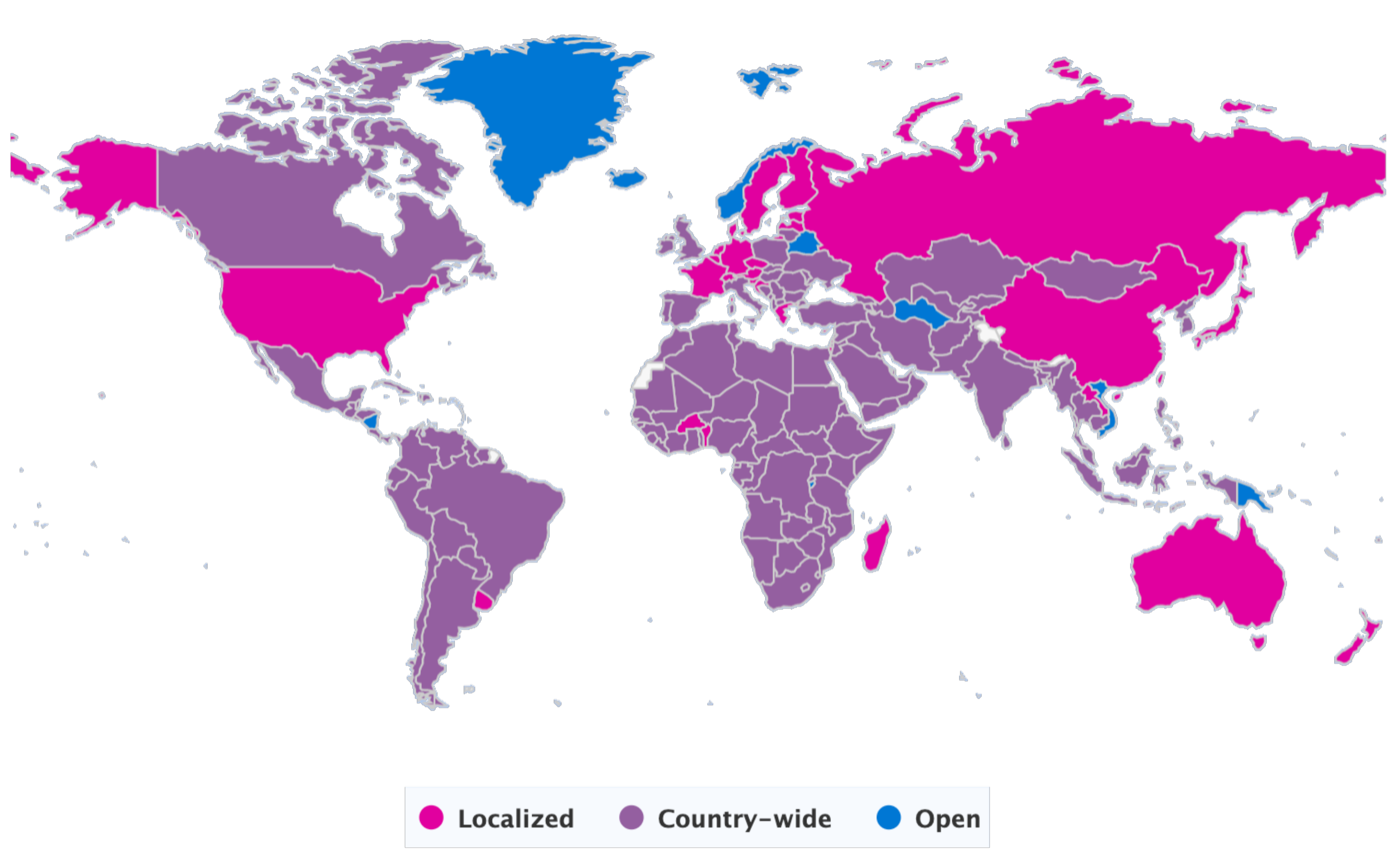
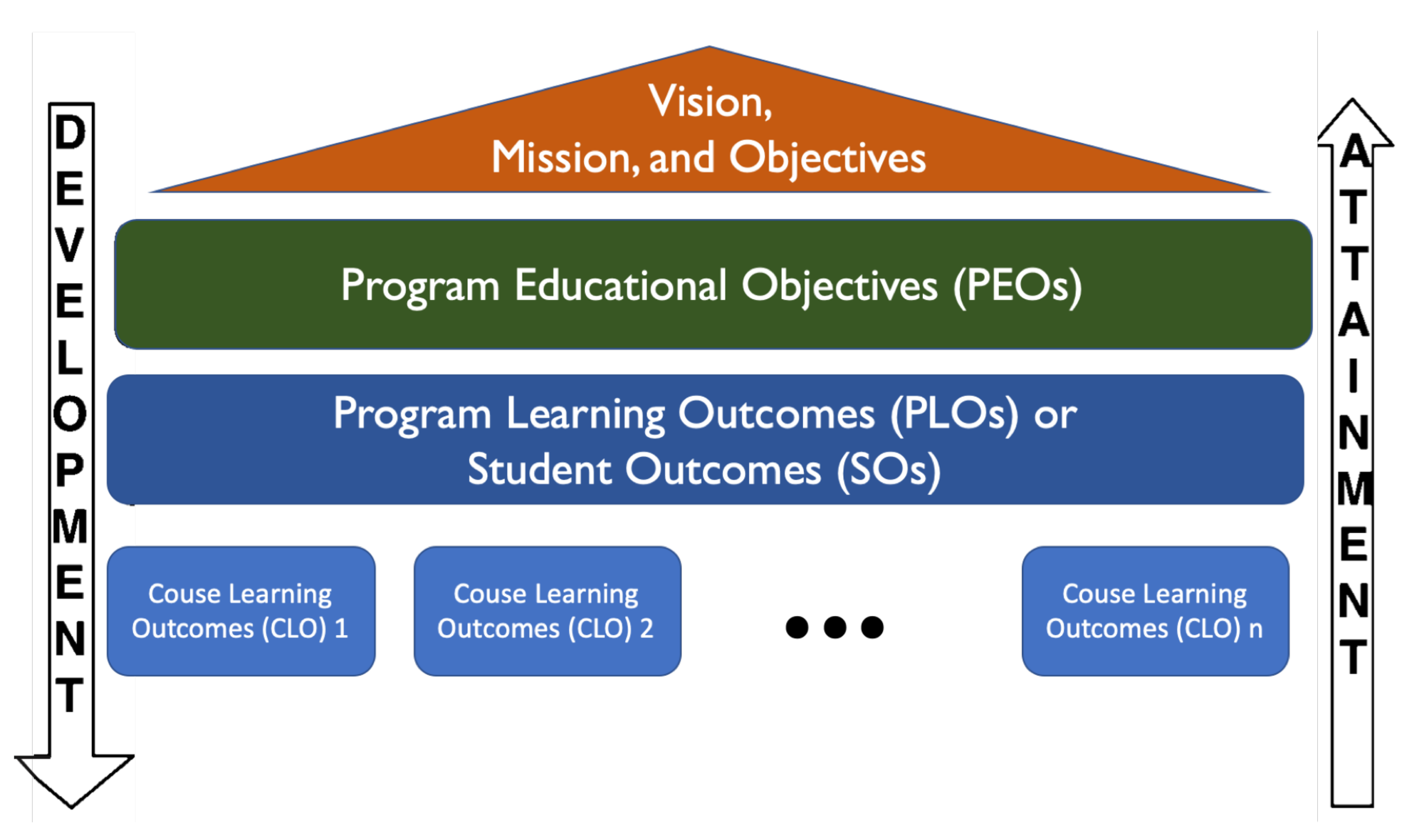
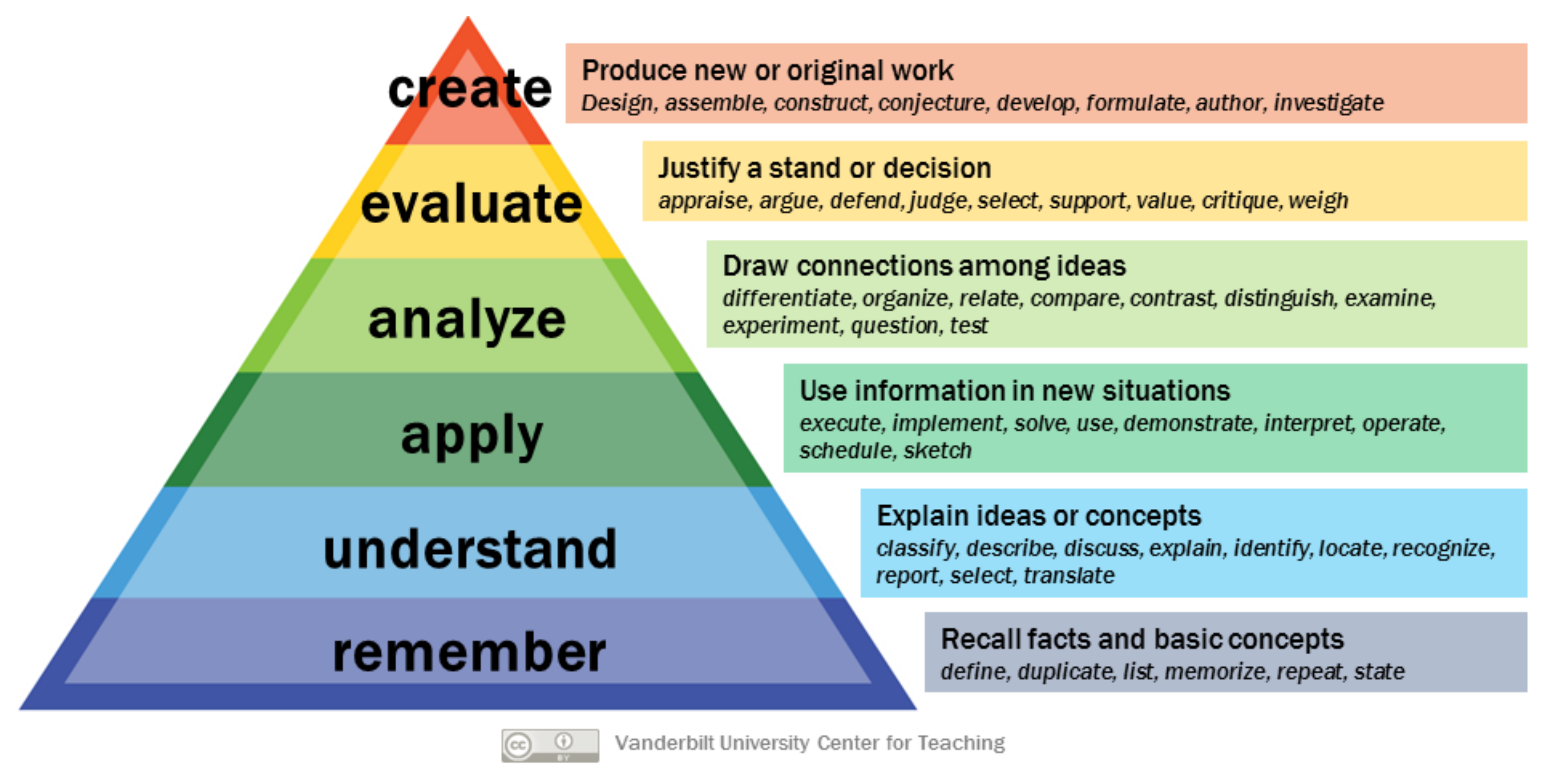
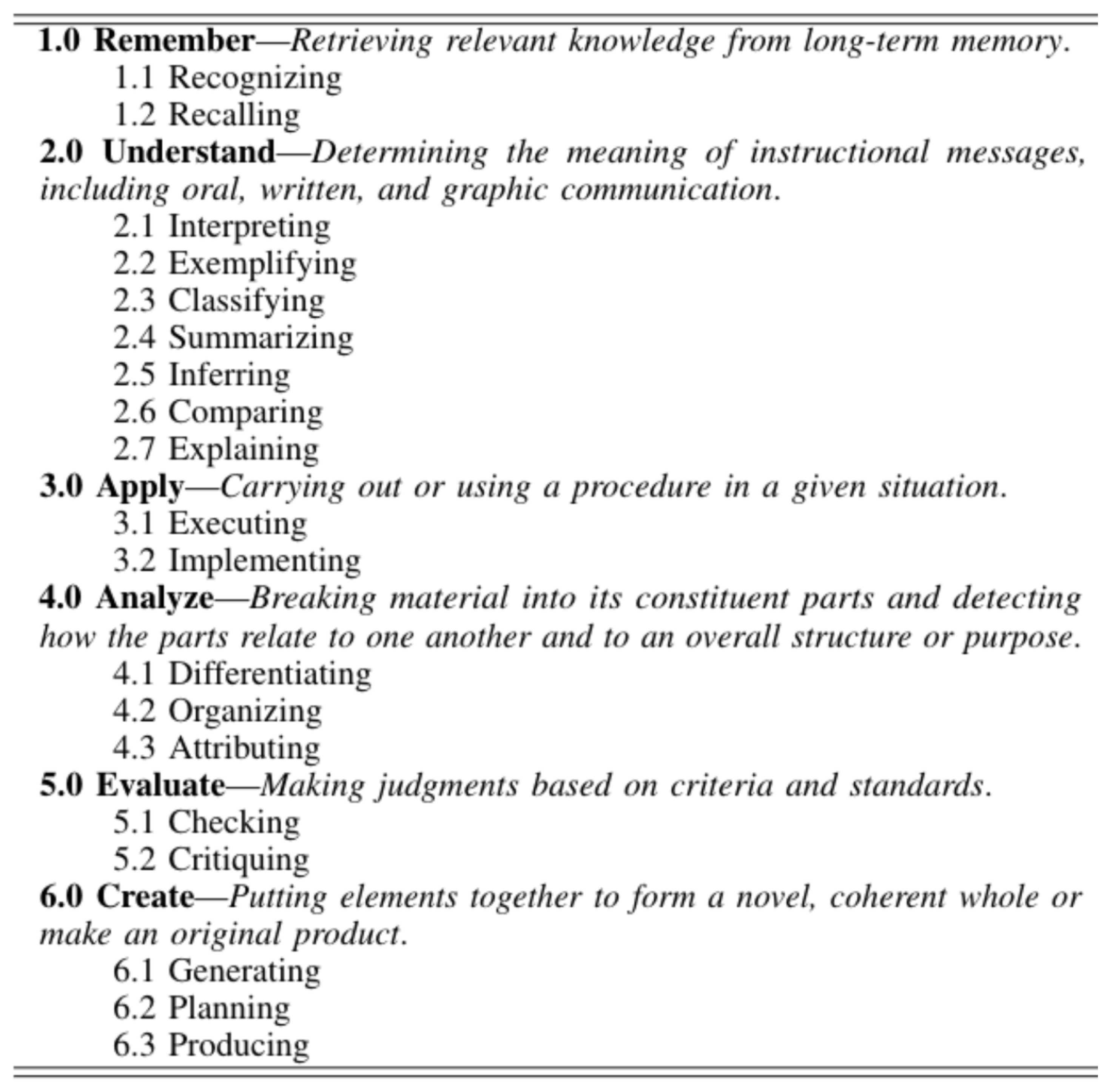
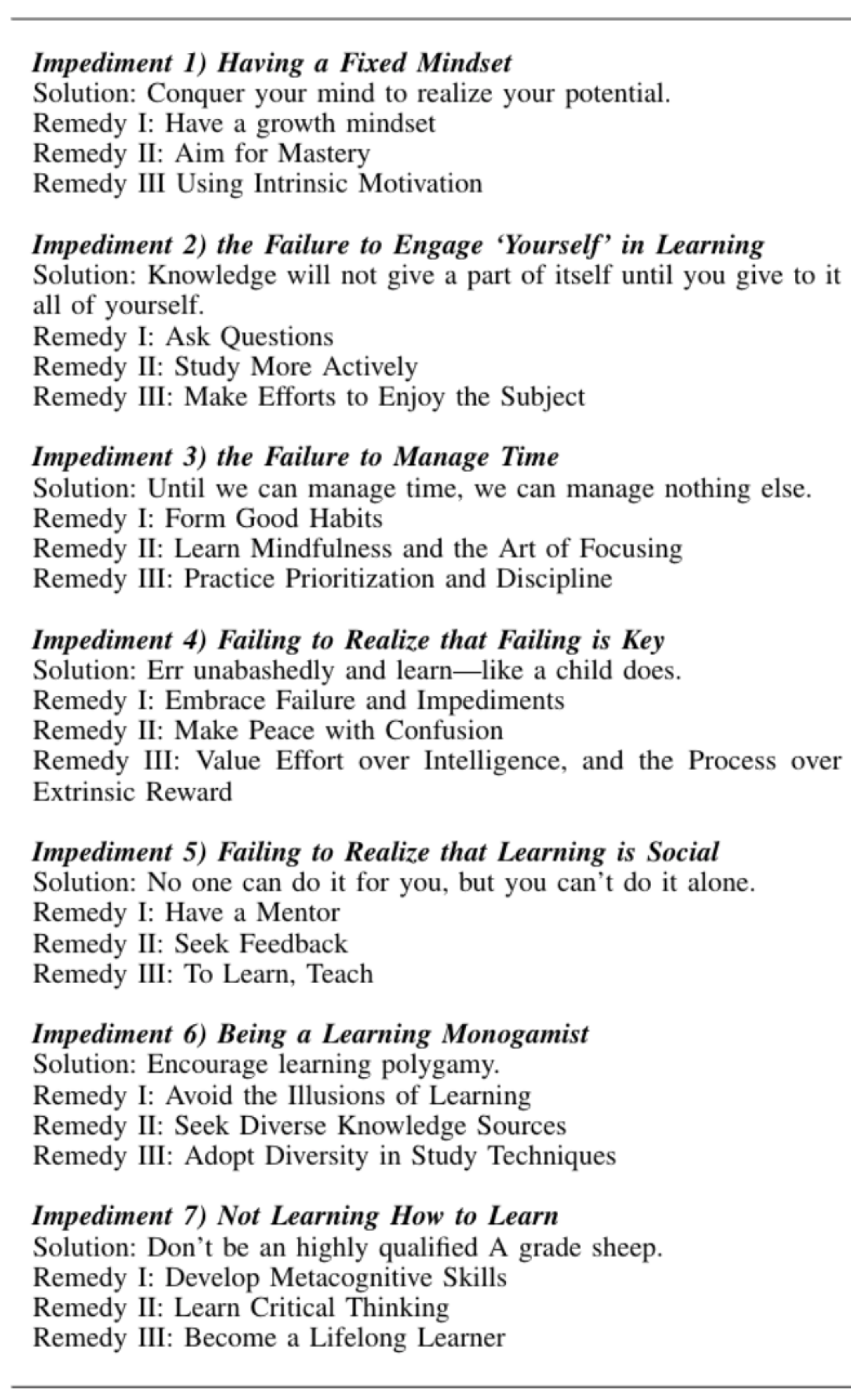
| (Step 1): Begin With The End In Mind (Section 2) |
| A: Knowing The Educational Objectives and Learning Outcomes |
| B: Aligning Effort With Goals, Objectives, and Outcomes |
| C: Motivation, Self-Efficacy, and Learning How to Prioritize |
| (Step 2): Upgrade Your Metacognitive Skills (Section 3) |
| A: Types and Levels of Learning |
| B: Avoiding Common Learning Mistakes |
| C: Learning 101: Learning How To Learn |
| (Step 3): Aim for Holistic Learning (Section 4) |
| A: Become A System Thinker |
| B: Building A Lattice Work of Models |
| C: Be Well-Rounded |
| (Step 4): Become Coachable (Section 5) |
| A: Seek Formative Assessment |
| B: Learn to Think Like An Assessor |
| C: Develop Self-Assessment Skills |
| (Step 5): Take Ownership of Learning (Section 6) |
| A: Active Learning |
| B: Leverage What Can Be Leveraged |
| C: Collaboration & Teamwork |
| (Step 6): Focus On Developing Authentic Skills (Section 7) |
| A: Develop An “Understanding” of the “Big Ideas” |
| B: Transfer of Learning |
| C: Uncoverage Rather than Coverage |
| (Step 7): Become a Lifelong Learner (Section 8) |
| A: Develop A Mindset For Continuous Lifelong Learning |
| B: Master The Instrumental Knowledge For Lifelong Learning |
| C: Develop by Practice the Skills for Lifelong Learning |
| Pointers | Explanatory Quote |
|---|---|
| Desirable Difficulties: | |
| (1) Effortful learning is better learning | “Practice that’s spaced out, interleaved with other learning, and varied produces better mastery, longer retention, and more versatility. However, these benefits come at a price: when the practice is spaced, interleaved, and varied, it requires more effort.”—Brown, Roediger, and McDaniel [20] |
| (2) To learn, you must forget, then interrupt forgetting | “It is only what breaks that grows.”—Unknown |
| (3) Disfluency/discomfort can be good for learning | “That which does not kill us makes us stronger.”—Nietzsche |
| Undesirable fixations: | |
| (1) Fixating on perfection: Why mistakes are required | “An expert is a man who has made all the mistakes which can be made, in a narrow field.”—Niels Bohr |
| (2) Fixating on fluency: Why fluency is not sufficient | “Rising familiarity with a text and fluency in reading it can create an illusion of mastery.”—Brown, Roediger, and McDaniel [20] |
| (3) Fixating on discipline: The upside of variety | “You don’t understand anything until you learn it more than one way.”—Marvin Minsky |
| For efficient learning, use optimal learning techniques: | |
| (1) Testing/retrieval practice as a learning tool | “In virtually all areas of learning, you build better mastery when you use testing as a tool to identify and bring up your areas of weakness.”—Brown, Roediger, and McDaniel [20] |
| (2) Spaced learning and interleaving | “The truth is, nothing in learning science comes close [to spaced learning] in terms of immediate, significant, and reliable improvements to learning.”—Benedict Carey [21] |
| (3) Aiming for mastery | “To be a sophisticated learner requires understanding that creating durable and flexible access to to-be-learned information is partly a matter of achieving a meaningful encoding of that information and partly a matter of exercising the retrieval process.”—Bjork, Dunlosky, and Kornell [27] |
© 2020 by the authors. Licensee MDPI, Basel, Switzerland. This article is an open access article distributed under the terms and conditions of the Creative Commons Attribution (CC BY) license (http://creativecommons.org/licenses/by/4.0/).
Share and Cite
Qadir, J.; Al-Fuqaha, A. A Student Primer on How to Thrive in Engineering Education during and beyond COVID-19. Educ. Sci. 2020, 10, 236. https://doi.org/10.3390/educsci10090236
Qadir J, Al-Fuqaha A. A Student Primer on How to Thrive in Engineering Education during and beyond COVID-19. Education Sciences. 2020; 10(9):236. https://doi.org/10.3390/educsci10090236
Chicago/Turabian StyleQadir, Junaid, and Ala Al-Fuqaha. 2020. "A Student Primer on How to Thrive in Engineering Education during and beyond COVID-19" Education Sciences 10, no. 9: 236. https://doi.org/10.3390/educsci10090236
APA StyleQadir, J., & Al-Fuqaha, A. (2020). A Student Primer on How to Thrive in Engineering Education during and beyond COVID-19. Education Sciences, 10(9), 236. https://doi.org/10.3390/educsci10090236





